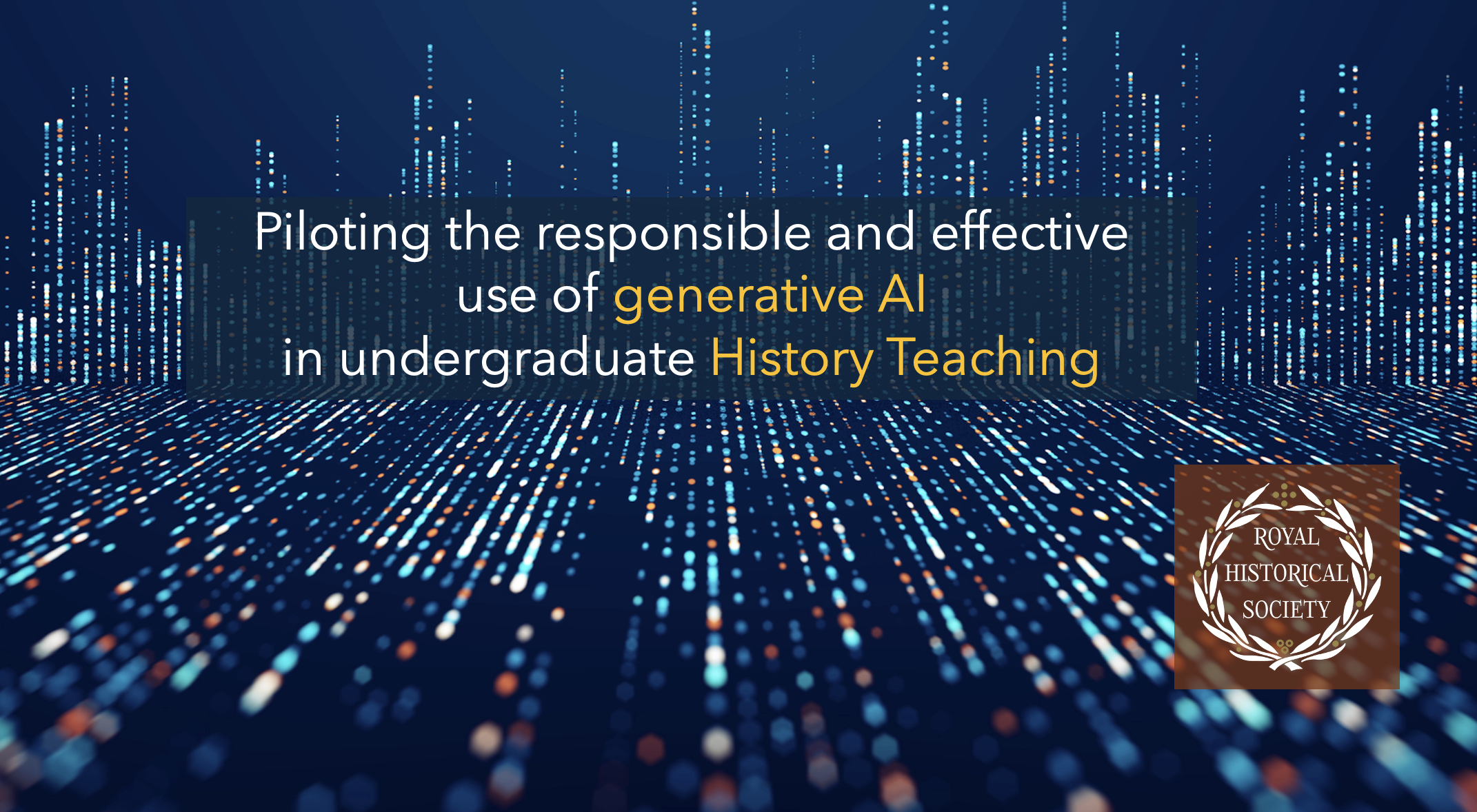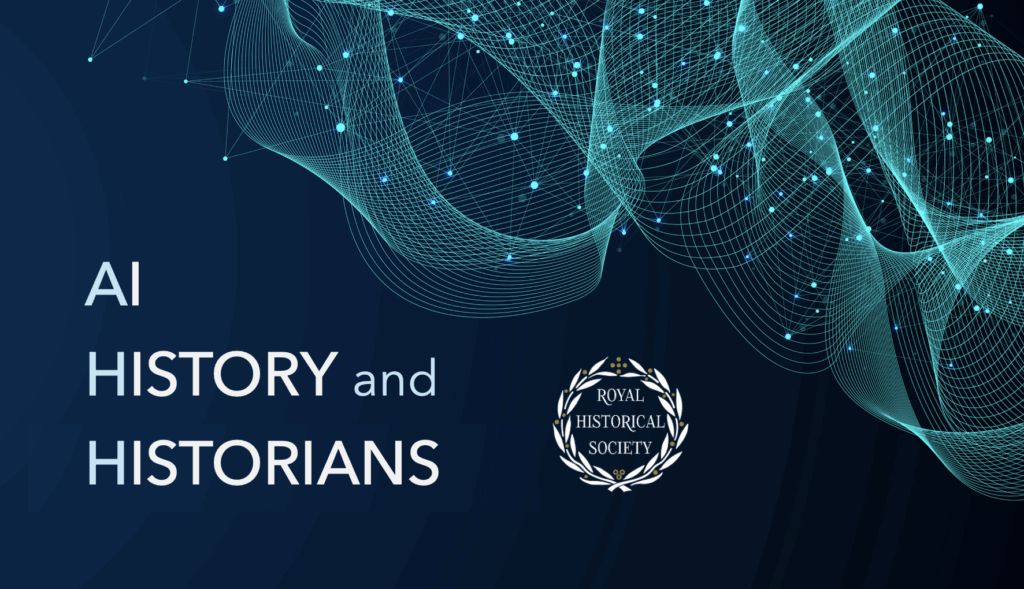How do UK history undergraduates routinely use generative AI in the classroom? In this post David Clayton, Henrice Altink and Esther Wilson (University of York) review the findings of their recent research project: ‘Piloting the responsible and effective use of generative AI in undergraduate History Teaching’.
This project asked students to answer a seminar question and to generate ideas for an undergraduate dissertation using Gen AI.
The study succeeded in making students aware of the shortcomings of using certain forms of generative AI in the teaching of history as a substitute for acquiring and applying specialist historical knowledge. It recommends that these activities are integrated into teaching practice and that teachers of history experiment with other forms of generative AI to support deeper student learning.
The York project was funded by the Royal Historical Society as part of its 2024-25 programme of Jinty Nelson Teaching Fellowships to support innovative teaching practice in higher education.
Nearly all UK undergraduate students supposedly now use generative AI to support their everyday academic work: to search for literature, summarise readings, generate ideas for written work, edit texts, create images, translate and transcribe texts, define and clarify the meaning of words and concepts, and answer essay questions (Department for Education, 2024). Yet much of the scholarship on generative AI in universities still concerns misuse during assessment.
To shift the focus towards understanding how students routinely use generative AI, we surveyed students and piloted two generative AI activities — answering a seminar question and generating ideas for an undergraduate dissertation.
Our pilot study succeeded in making students aware of the shortcomings of using certain forms of generative AI in the teaching of history as a substitute for acquiring and applying specialist historical knowledge.
We recommend that these activities are integrated into teaching practice and that teachers of history experiment with other forms of generative AI to support deeper student learning.
Method
We first surveyed all second-year History students at the University of York on their knowledge and use of generative AI, then piloted the two tasks, and finally gained feedback on these activities from tutors and students. Activities were trialled in 10 second-year seminar groups representing a cross-section of history, that is, medieval, early-modern and modern and British and non-British history.
In the first activity, students answered a question in a plenary discussion led by the tutor, using knowledge they had acquired from specialist set readings. The tutor then fed that same question through Google Gemini and the class evaluated the answer. In pairs, students fed the same question into Gemini, adjusting queries to see if they could improve answers, which were then evaluated.
In the second activity, the tutor asked Google Gemini to provide ideas for an undergraduate dissertation on the seminar topic. This was followed by a brief discussion of the answer before students in pairs fed the same question through Gemini and then added queries to see if it could provide possible research questions and direct them to relevant primary sources.
Findings
Modelled on the recent survey of history students carried out by Neville Morley (2024) at Exeter and by the Higher Education Policy Institute (HEPI, 2025), our survey revealed that only a third of the respondents had used generative AI tools in their university work, and that they had done so mainly to summarise texts and for editorial support. Like other Arts and Humanities students, history students are not only less familiar with but are also less willing to use generative AI tools than STEM students (Josh Freeman, 2025).
Our respondents considered the ethical and practical implications of using generative AI, weighing up benefits against perceived costs. Students identified costs as comprising additional carbon and water, the loss of essential thinking skills, having to sift through biased and erroneous results, providing private data to large language models and contending with copyright infringement.
Half of the respondents strongly opposed the use of generative AI … half accepted that generative AI was here to stay and supported training.
A low response rate (15%) probably explains a skew in our survey results. Half of the respondents strongly opposed the use of generative AI, and would not even consider outsourcing referencing and formatting to free up time for analysis. The other half of the respondents accepted that generative AI was here to stay and supported training in generative AI in the undergraduate curriculum, particularly from a future career perspective.
While our survey respondents showed polarised views towards the use of generative AI in history, the students (and also staff) who took part in the two activities broadly agreed on the shortcomings of generative AI. They found that generative AI-generated answers to a seminar question were of poor quality because they:
- Offered only surface-level positions
- Simply did not answer the question
- Did not summarise set course readings
- Were biased towards great events, policies and individuals
- Were biased towards certain time periods and geographical areas.
Students and staff noted moreover that even when the same question was fed into Google Gemini, different answers were provided and that adjusting queries to generate a more complete answer was time-consuming and did not necessarily lead to better answers. They also realised that generative AI was not able to back assertions with evidence and struggled to provide references to the relevant literature. Tutors discussed with students why Google Gemini was unable to provide compelling answers, leading to speculations about the materials that had been used to train the model and inequalities created by materials behind paywalls.
Students learned that while generative AI can be good at summarising a text, and as such could be a useful starting point for studies, it struggles to provide an argument.
Most seminar attendees were underwhelmed by generative AI, with Google Gemini-answers sometimes phrased plausibly even though they were wrong or misleading. They also learned that while generative AI can be good at summarising a text, and as such could be a useful starting point for studies, it struggles to provide an argument; that is, indicating what is the most important factor/issue and how different factors/issues are connected — the key to good history writing.
Due to timetable clashes, not all seminar groups were able to undertake the second activity. Those that found time for this task felt that generative AI worked relatively well as a springboard to generate ideas for an extended final-year project, but that it struggled to present feasible, focused and researchable questions. It was also unable to adequately distinguish between secondary and primary sources.
Conclusions
The two activities showed students the shortcomings of using generative AI to support advanced forms of learning on specialist undergraduate history courses. At best, students and staff thought it could be a starting point before doing specialist reading but ultimately it was unable to support critical thinking. Or as one of the students taking part in the pilot activities said: ‘it does not have the analytical ability we do’.
Our project did not test how generative AI could be used to synthesise large amounts of different types of information as part of undergraduate history teaching. Beyond the scope of this project, the real gains may be through the use of AI systems, such as Google NotebookLM, that allow students to bring a range of primary sources into dialogue with one another and possibly the secondary literature, as some historians already do (New York Times, 2025).
About the Authors
David Clayton is Professor of Modern History at the University of York, and a recipient of an RHS Jinty Nelson Teaching Fellowship for 2024-25.
Henrice Altink is Professor in Modern History and Co-Director of the Interdisciplinary Global Development Centre at the University of York, With David, Henrice was a recipient of an RHS Jinty Nelson Teaching Fellowship for 2024-25.
Esther Wilson is a PhD researcher in the Department of History, University of York, and a research assistant for this project.
Articles cited in this post
- ‘Generative artificial intelligence (AI) in education’, Department of Education policy paper, 2024 (updated 10 June 2025)
- Neville Morley, ‘History Students’ Use of GenAI’, Royal Historical Society blog 29 July 2024
- ‘Student Generative AI Survey 2025’, Higher Education Policy Institute (26 February 2025)
- ‘A.I. Is Poised to Rewrite History. Literally.’, New York Times (16 June 2025)
Jinty Nelson Teaching Fellowships

Launched in 2023, the Jinty Nelson Teaching Fellowships support History teaching in UK Higher Education. The Fellowships are named after Dame Jinty Nelson FBA (1942-2024), President of the Royal Historical Society between 2000 and 2004.
Fellowships support historians in Higher Education who wish to introduce new approaches and initiatives to their teaching—and for which funding, at one of three levels (£500, £1,000 and £1,250 per award), is required to make this possible. Fellowships may also support those seeking to undertake a short study of an aspect of History teaching in UK Higher Education: for example, within a department or more widely.
In 2024-25, the Society awarded seven Fellowships to support innovation in teaching: further details are available via the grant page of the RHS website. The call for Fellows for the academic year 2025-26 closed in May and recipients will be announced shortly.
History and Generative AI: further reading from the Royal Historical Society
In September 2025, the Society will host a day workshop at the University of Edinburgh to consider ‘Using GenAI to Teach History’. Outcomes from this event will lead to guidance notes on Gen AI in teaching from the Royal Historical Society.
Further resources and articles relating to the History and GenAI are available here.


